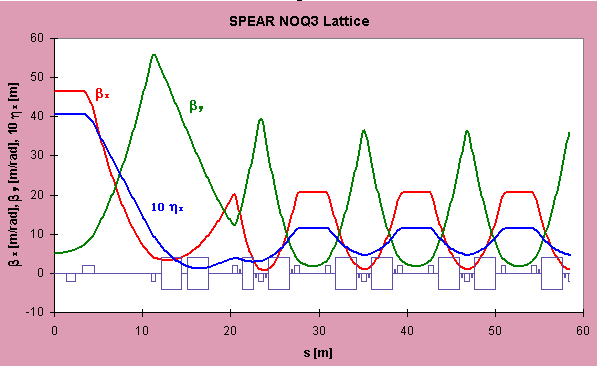

Beginning with the FY96 user's run, the SPEAR storage ring is being operated with a new optics configuration (NOQ3), which replaces the present Low Emittance optics (LBLE) that was introduced several years ago. The LBLE optics, designed and commissioned by James Safranek, reduced the emittance of SPEAR by a factor of four (at 3 GeV) from the emittance of the previously used High Energy Physics optics. The emittance of the LBLE optics is close to the minimum emittance that is achievable with the present magnet arrangement in SPEAR.

Figure 1: Optics functions for the SPEAR NOQ3 configuration. The graph shows
one quarter of the ring's circumference. The lattice functions for the rest
of the circumference can be obtained by applying mirror operations to the
part that is displayed, here.
Figure 1 shows the optical function (beta_x, beta_y, eta_x) of the NOQ3 optics for one (symmetry) quarter of the SPEAR ring. The transition to the NOQ3 optics eliminates some of the problems that the LBLE optics still had, while maintaining the low emittance. These problems originate from the strong Q3/Q2 quadrupole families that are located close to the former interaction regions used for high energy physics experiments. These magnets were needed to tightly focus the beam at the interaction points to increase the luminosity of the colliding beams. The LBLE optics still exhibits a small beam size at the interaction points even though it is not needed for synchrotron radiation operation. Due to their strengths, these Q2/Q3 quadrupole magnets had a strong influence on beam operation. Fluctuations in strength introduce tune and orbit instabilities. To make things worse, the magnet supports respond to fluctuations of the outside temperature, and the controlling power supplies are old and do not adhere to present day state-of- the-art stability criteria. The new optics reduces these problems significantly by removing the Q3 quadrupole family and reducing the strength of the Q2 family by about 80 %. These changes decrease the magnets' impact on electron and photon beam stability, improve SPEAR's dynamic aperture, and is also expected to reduce the annual power bill by an estimated $100,000.
The NOQ3 optics has been intensively tested and characterized in Accelerator Physics shifts during the 1995 user's run. The optics has, by now, proven itself in every-day operation. Up to now, modifications to accelerator hardware for the implementation of the new optics had been limited to preserve the option of going back to the LBLE optics. This meant especially that the Q3 magnet was not yet physically removed. In order to run the NOQ3 optics without actually removing the Q3 magnet, the vacuum chamber had to be enlarged in that magnet. This was done during the 1995 shutdown.
The Q3 quadrupole family can now be removed from the accelerator and the Q2 quadrupoles and power supplies can be replaced by more adequately sized (i.e. smaller) components. The Q2 magnets are already operated with the former Q3 power supply, which matches better their new power requirements.
The new optics offers a path to further modifications that could create long, quadrupole-free, straight sections by moving the remaining Q2 magnet away from the center of the symmetry points. Those straight sections could accommodate long insertion devices.
The NOQ3 project was initiated and supported by Max Cornacchia. The optics was developed by Heinz-Dieter Nuhn, with guidance about tune selection by Martin Donald. Hardware modifications were developed and implemented under the leadership of Richard Boyce. The commissioning was carried out by a group coordinated by Heinz-Dieter Nuhn, including Ed Guerra and the SPEAR Operators (Machine Operation, especially injection and configuration control), Jeff Corbett and Bob Hettel (Orbit Control and Beamline Steering), Teresa Troxel (Beam Profile Measurements), Hal Tompkins and the X-Ray Staff (Photon Beam Characterization), Phuong Tran (Phase Space Characterization and Coupling), Dave Gough and Ray Ortiz (Kicker Polarity Changes), Martin Lee (Coupling Analysis), and Nisy Ipe, Ian Evans, and OHP (Radiation Control).
Selection of Experimental Shift Summaries Relevant the Subject
Shift Summary: "Lattice Tuning" on January 9, 1996
Shift Summary: "Lattice Tuning" on January 23, 1996
Shift Summary: "Model Correction" on February 13-14, 1996
List Publications
H.-D. Nuhn, "An Optimized Low Emittance Lattice for SPEAR." Proceedings of the 4th European Particle Accelerator Conference (EPAC94), London, England, June 27 - July 1, 1994, SLAC-PUB-6547, SLAC/SSRL-0083.